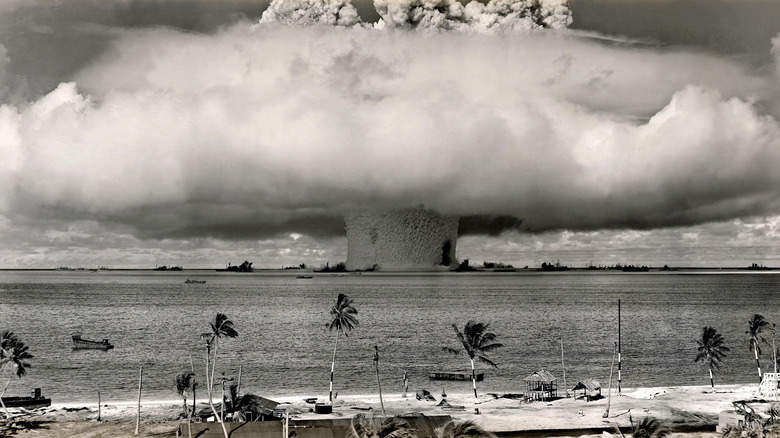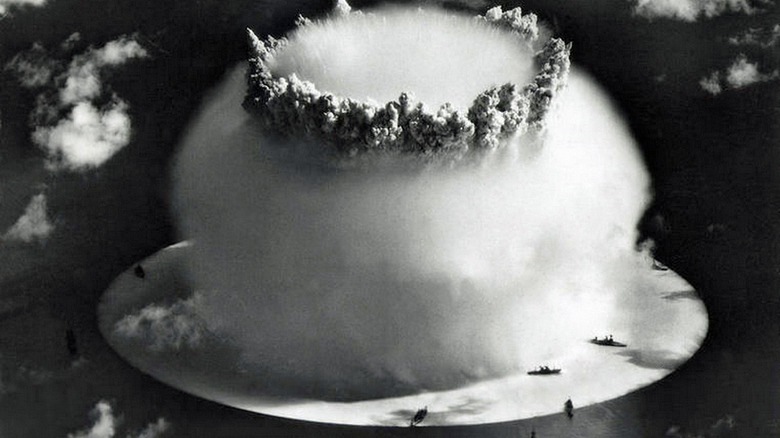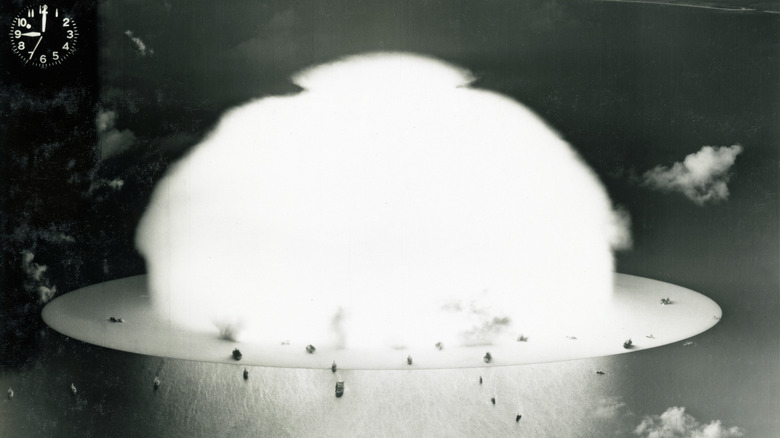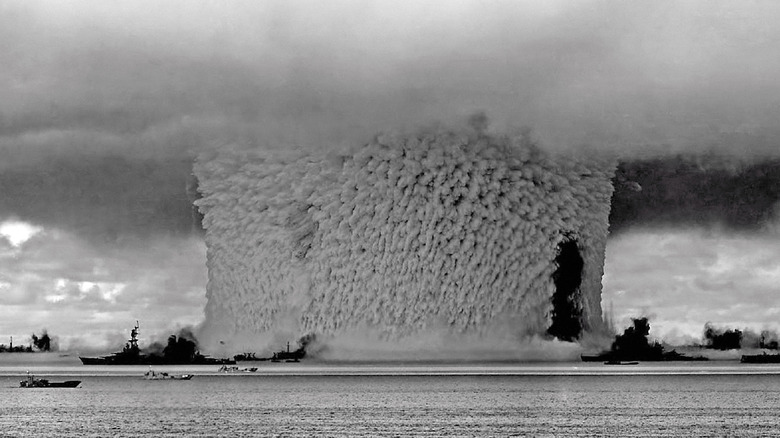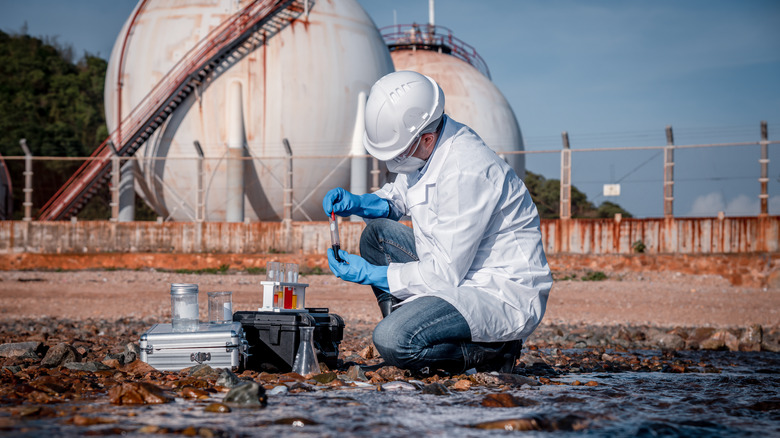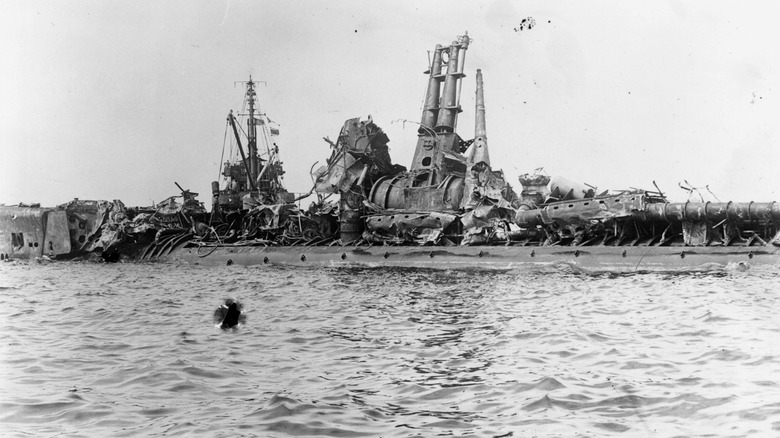What Happens When An Atomic Bomb Goes Off Underwater?
We've all seen some variation of the following trope: A bomb has been detonated and is getting ready to explode. The countdown begins. The world braces for impending doom. Suddenly, a hero bursts onto the scene and races against the clock, tossing the bomb into a nearby ocean just in the nick of time. The would-be-doomed characters and watchful audience breathe a collective sigh of relief.
But is that all it really takes to avoid a nuclear disaster? Is the ocean any match for an exploding atomic bomb? According to Atlas Obscura, there was a time in the mid-1940s when United States military leaders believed they could brave the waves of a nuclear attack if an atomic bomb exploded deep beneath the surface of the sea. However, several extremely unfortunate test runs blew that theory right out of the water — literally. Today, we have a much more accurate idea of what happens when an atomic bomb plummets deep into a large body of water, and it's certainly nothing to celebrate (via The National WWII Museum).
Enter Operation Crossroads, the first public underwater nuclear test
In the aftermath of World War II, international fears of the atomic bomb swept the globe, and with good reason. On August 6, 1945, in the midst of international war, the U.S. dropped the first and second atomic bombs in history over the Japanese cities of Hiroshima and Nagasaki. According to History, unfathomable devastation ensued. Hundreds of thousands of people from the two manufacturing metropolises were killed — some instantly and others slowly and quite gruesomely.
According to The National WWII Museum, the event sparked staunch opposition to atomic bombs, particularly from notable intellectuals of the time. In addition to the creepy prospect of the whole world being encompassed by a mushroom cloud of radiation, there was also a great deal of confusion about how these bombs would react in certain situations. While private underwater tests had already been conducted in secret, the radioactive aftermath was neither public nor understood. For this reason, military leaders devised a plan to publicly detonate not one, not two, but three atomic bombs. The first of these would graze the water, the second would be a shallow underwater explosion, and the third and final eruption was slated to take place thousands of feet beneath the sea. It's important to note that the last bomb never happened because the aftermath of the first two was so horrific.
When an atomic bomb goes off underwater, a giant bubble rises up
Picture this: It's 1946. Operation Crossroads has reached its second stage. Reporters and politicians from all over the world gather to witness the second shot, an underwater blast poised to make a serious splash. According to The National WWII Museum, this was precisely the scene that transpired on July 25, 1946, when the second bomb — oddly named "Helen of Bikini" — exploded 60 feet beneath the waters of Bikini Atoll in the Republic of the Marshall Islands (via Atlas Obscura).
The Historical Radiological Assessment, a government publication on past and present radioactive materials past and present, described the blast with the following statement, "The first effect of the blast was a tremendous bubble of water and steam that broke the ocean's surface." There, on the radioactive waters, as the giant bubble rose and broke, sat hundreds of test ships divided into the categories of target or nontarget vessels. A dozen of them immediately sunk, and that's not all — according to History, the destruction happening on the surface was really just a foreshadowing. Far beneath the surface, the hot gas that caused the massive bubble to appear had also carved a 2,000-foot-wide crater right into the floor of the sea.
When the bubble breaks, colossal waves scourge the sea
1940s scientists and thought leaders did not expect a submerged bomb to have such a tremendous impact. The Historical Radiological Assessment described the shallow underwater bomb, Helen of Bikini, as being much more devastating than the first Hiroshima-like blast that merely grazed the island. According to The National WWII Museum, after Helen of Bikini was detonated from a modified barge positioned 60 feet beneath the surface and the ominous bubble broke, the toxic waters rose once more, transforming into a massive 90-foot wave. Incidentally, this is just 11 feet shy of the height of the wave at Nazaré, which is the tallest wave that's ever been surfed (via Live Science) and roughly the size of a 10-story building (per Measuring Stuff). Yes, that big!
When the building-sized wave finally collapsed, it swept over the target and support ships alike and eventually engulfed all of the islands of the Atoll. This was indeed a tragedy because Bikini Atoll was home to approximately 167 Bikinians, all of whom were immediately displaced after the eruption, forced into exile and starvation (via The Conversation).
Radioactive debris contaminates everything
Based on the experiment, it is clear that detonating an atomic bomb underwater garners the same horrific results as detonating one over land. This is true in the short-run, as a 90-foot tidal wave enveloped the surrounding region devastating all in its tracks (via The National WWII Museum). It is equally true in the long run, for shortly after the wave dissipated, radioactive debris fell from the sky, contaminating the sand and sea, not to mention the nearby naval ships, support vessels, coral, plus the islands and the lagoon (per The Historical Radiological Assessment). And, because test and target ships were involved, there was an estimated 610,000 gallons of contaminated fuel among the wreckage.
These radioactive aftereffects take place due to the bomb's plutonium splitting, an action scientifically dubbed a fission. It's notable to point out that while 1940s scientists anticipated the presence of some beta and gamma radiation, they also found evidence of alpha contamination, which was unexpected. According to the Australian Radiation Protection and Nuclear Safety Agency, alpha rays can be naturally occurring and are generally regarded as safer than other nuclear particles because they penetrate material at slower rates and are highly ionizing. Even so, the destruction from this single blast is evident to this very day (via History).
Decades of cleanup won't eradicate the mess
Ever since the nuclear underwater test bombed, taking out islands and contaminating coral and lagoons, military officials have been attempting to clean up the mess. According to The Historical Radiological Assessment, decontamination efforts began that morning in 1946 at Bikini. Shortly afterward, it was determined that the Bikini Atoll's radioactivity was hindering all efforts to decontaminate, and objects were shipped to the Kwajalein Atoll for further scrutiny.
History reports that to this very day, the Bikini Atoll is unfit for human habitation due to background gamma radiation presence and contaminants in the food, soil, and surrounding waters of the sea. Now that we know an underwater atomic bomb can be this destructive, we've changed our perception of nuclear war, even from a pop culture perspective. Have you ever noticed that modern onscreen superheroes tend to save the day by hurling nuclear bombs into outer space rather than simply tossing them into a nearby ocean? Perhaps this is why.
